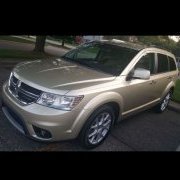
sppmaster
-
Posts
27 -
Joined
-
Last visited
-
Days Won
1
Reputation Activity
-
 sppmaster reacted to tsteves5 in Upgrade Standard Brakes to Heavy Duty
sppmaster reacted to tsteves5 in Upgrade Standard Brakes to Heavy Duty
My 2011 Journey has the Standard-Duty brakes with the single-piston front calipers and the 302 mm rotors. These brakes are under sized, eat up pads, and have a nasty tendency to warp. My Town and Country has the Heavy-Duty brakes, dual-piston front calipers, larger pads, and 330 mm rotors. These are much more robust, last a long time, and seem to rarely warp. Dodge began offering the HD brakes as an option on the 2012 and later Journeys.
I decided to see if I could upgrade my 2011 front SD brakes to HD brakes. It wasn’t difficult. All I needed was a set of dual-piston calipers with brackets, a set of 330 mm rotors, and a set of new pads for those rotors. The existing steel shield needed to be cut slightly to allow for the larger brackets. Everything else bolted right into place and fits within the existing wheel.
I did have some issues with the new/rebuilt calipers. It took a couple of sets until I found some that worked correctly. The first set of calipers has frozen slide pins that would not budge. The second set had pistons that wouldn't retract slightly when the brake pedal was lifted.
I just thought I would pass along the info if anyone else is frustrated with their SD brakes.
-
 sppmaster reacted to SuperDave in 2017 Dodge Journey SE annoying suspension rattle.
sppmaster reacted to SuperDave in 2017 Dodge Journey SE annoying suspension rattle.
Maybe this may help someone….
I have had a front suspension rattle on my 2011 R/T for years. Tried everything, new struts, sway bar bushings, sway bar stabilizer links (twice, which seemed to help every time initially) and also replaced the lower control arms (that was not a waste of money as they were worn out). Vehicle has 230000 km on it so it doesn’t owe me much but the rattle on rough roads was driving me crazy. Sounds like a strut was broken etc.
Most of the work was done at different local mechanics but this week i decided to do the work myself and figure out the problem once and for all.
I looked over all the bodywork, fender panels, adding new fasteners and push pins everywhere as they were worn out. Didn’t help.
Finally decided to replace the stabilizer sway bar links one more time as they’re inexpensive and it seemed to help initially before but only for a day or two.
What i discovered was the strut and the stabilizer cross bar holes to mount the sway bar links are oversized. i inspected the old sway bar links and there was wear on the threads even though they we’re crazy torqued down. The hole on the strut that receives the sway bar link also showed some sign of wear and elongation. Poor manufacturing standards.
I was able to fabricate a shim/washer that took up most of the excess slack from the oversized holes and installed the new sway bar links.
The car has never been so quiet since.
-
 sppmaster got a reaction from OhareFred in Sinking Brake Pedal
sppmaster got a reaction from OhareFred in Sinking Brake Pedal
Yes you've been told right... furthest first. And you are right... pre ABS era.
The Left Rear Wheel (in this case particularly) is furthest from the master cylinder. The master cylinder is on the drivers side then the brake line is going to the ABS/HCU block which is on the passenger side and then going to the left rear wheel which is furthest from ABS/HCU respectively from the Brake Master Cylinder .
-
 sppmaster got a reaction from OhareFred in Sinking Brake Pedal
sppmaster got a reaction from OhareFred in Sinking Brake Pedal
Thanks.
Are you sure about the order.
I've read in this NHTSA Safety Recall it is
NOTE: The following wheel sequence should be used when bleeding the brake
hydraulic system. The use of this wheel sequence will ensure adequate
removal of all trapped air from the brake hydraulic system.
Left Rear Wheel
Right Front Wheel
Right Rear Wheel
Left Front Wheel
-
 sppmaster got a reaction from Locosiete in Sinking Brake Pedal
sppmaster got a reaction from Locosiete in Sinking Brake Pedal
Yes you've been told right... furthest first. And you are right... pre ABS era.
The Left Rear Wheel (in this case particularly) is furthest from the master cylinder. The master cylinder is on the drivers side then the brake line is going to the ABS/HCU block which is on the passenger side and then going to the left rear wheel which is furthest from ABS/HCU respectively from the Brake Master Cylinder .
-
 sppmaster reacted to John/Horace in Sinking Brake Pedal
sppmaster reacted to John/Horace in Sinking Brake Pedal
The caliper piston needs to make contact when pressure bleeding to properly push the air out. I have had a rear disc brake caliper not making contact with new pads and rotor on a Hyundai vehicle. It had the locking parking brake caliper pad set up like on Journey.
Cycling parking brake did not seem to help any.
After messing around I ended up adjusting piston for more contact and no gap. Air then pushed out with a gravity bleed, and pedal cycling. So this is correct helpful information for Journey rear calipers with air trapped in system. Pedal height is also affected by pad wear, new pads keep it slightly higher.
-
 sppmaster reacted to FROGBOX in Successful BIG BRAKE upgrade on 2011 Crew
sppmaster reacted to FROGBOX in Successful BIG BRAKE upgrade on 2011 Crew
The pictures were hosted by fototime and they had a catastrophic event a few months ago. All photos were lost and they basically ceased operating.
I lost over 1000 pictures. I had hundreds of how to posts like this one as a member of tdiclub. It will be a monumental task to try to find all the pictures in my backed up drives, but I will see what I can do.
-
 sppmaster reacted to FROGBOX in Successful BIG BRAKE upgrade on 2011 Crew
sppmaster reacted to FROGBOX in Successful BIG BRAKE upgrade on 2011 Crew
Well, I said I would do it, so I did. I was going to source all the parts new, but I was able to find a wrecked 2013 Journey and bought the calipers, brackets, rotors & pads for $150 total. That saved me about $350 from buying new and made it much less of a risk if it didn't work.
First, the disclaimer......
PLEASE do not attempt this upgrade unless you know what you are doing. Use common sense when jacking & supporting a vehicle, they are heavy and can move. Always use jack stands. And most of all, be careful.
First, here are some comparison pictures to show the huge difference between the brakes.
As you can see, the calipers are much bigger. And, they are dual piston calipers too, meaning you get more pressure on the pads for better braking. The rotors are also much larger. The old ones are 302mm and the new ones are over an inch bigger at 330mm:
I did want to replace the pads & rotors, but since these brakes are so new being available only on 2013 & late 2012 cars, the aftermarket availability is limited for replacement pads & rotors. So if you can wait to do this upgrade till aftermarket parts are available, you can save a few bucks. I will be throwing on a set of new ceramic pads & rotors next year. I hate the brake dust created by the OEM pads.
-
 sppmaster reacted to FROGBOX in Successful BIG BRAKE upgrade on 2011 Crew
sppmaster reacted to FROGBOX in Successful BIG BRAKE upgrade on 2011 Crew
Now, on to the procedure....
The first step is to jack up the truck and remove the wheels. If you need instructions for this part, perhaps you should consider getting someone else to help you or pay to have this done .
Once the wheels are off, remove the calipers. You can remove them as complete unit with the brackets, but I chose to do it seperately as there is more clearance for the bracket bolts with the caliper out of the way. The first thing I did was to remove the brake lines. I used a small pair of needle nose vice grips to clamp the hose so you don't loose too much fluid. Put a bucket under the caliper to catch the fluid that leaks out. You need a 15mm wrench to remove the banjo bolt holding the brake line to the caliper.
Once you have the line off, you need a 15mm and a 13mm wrench to remove the caliper from the slider pins.
With the 2 x 13mm bolts removed, the caliper should wiggle off. Now, you can easily access the 2 x 21mm bolts holding on the bracket:
I needed a breaker bar to get enough leverage to brake those bolts loose. If you don't have one in your tool box, they are not expensive at Princess Auto (Canada) or Harbor Freight (US). You could also use a pipe on your ratchet handle too.
Once it is broken loose, finish with ratchet:
Next step is to remove the rotor. I had to pound mine off with a rubber mallet. It had rusted to the hub. These brakes were changed 1 year ago and 16,000 km (10,000 miles) by the dealer. I was surprised at how stuck they were. To prevent this from happening again, clean & lube the hub before reinstalling the rotors.
I used a wire wheel on the end of a drill to clean up the rust on the hub:
I then applied some anti sieze to the hub to prevent the new rotor from rusting to the hub again. You will be glad you did this when you go to change your brakes again. Coat the entire mating surface:
The next step is to reinstall the new components. Install the rotor first. I like to use a lug nut to hold it in place while I attach everything else so it doesn't wobble around. I use a wrench as a spacer as the stud is too lung and will bottom out in the nut before it gets tight.
Then, attach the bracket and caliper. It fits the original spindle with no issues at all. You can also change the backing plate as well. They are not expensive, but I didn't in this case as I was just test fitting the parts I had before spending money on new plates. I will replace my plates when I do my next brake job.
Here is the new caliper installed:
At this point, you will need to bleed the brakes. I don't want to go into too many details on that. I'm sure there are enough tutorials on the web & you tube that you can figure out how that works. Basically, you need one person in the vehicle to pump the brakes to pressurize the line, then, while holding down the brake pedal, you crack the bleed screw to allow the air to escape. the pedal will sink to the floor, then close the bleed screw and repeat till there is no more air coming out of the caliper, only fluid.
The bleed screw is 11mm:
I use a piece of clear hose to help direct the fluid into a bucket to keep the work area clean. You can also see the fluid passing through it and can tell if there is any air coming out as well:
Once all the air is bled out, tighten the bleed screw. It does not have to be really tight. Just snug it up. if you make it too tight, it may snap. Cap the screw with the rubber boot, replace the wheel and repeat on the other side.
-
 sppmaster reacted to FROGBOX in Successful BIG BRAKE upgrade on 2011 Crew
sppmaster reacted to FROGBOX in Successful BIG BRAKE upgrade on 2011 Crew
Here are some before & after pictures:
Old caliper:
New caliper:
Old with wheel (wow, they look tiny inside a 19" wheel ):
New with wheel:
That's about it. Just a couple of things before I go.....
Be advised that with these bigger brakes, you will need a minimum of 17" wheels to clear. So some Journey owners with smaller wheels will have to budget for new wheels as well as the bigger brakes.
Parts list:
Part Part number Qty
Pads 68159579AC 1
Rotors 04779712AA 2
Caliper (L) 68144161AA 1
Caliper ® 68144160AA 1
Carrier (bracket) 68159578AA 2
Pin Kit (sliders) 68144165AA 2
Spring kit (pads) 68159523AB 1
Dust shield (L) 04779907AA 1
Dust shield ® 04779906AA 1
As mentioned before, to save some money, you may be able to find the pads & rotors aftermarket. The calipers, brackets, pins and backing plates are probably dealer only items, but can be found cheap on line at the following sites:
www.factorymoparparts.com
www.moparoverstock.com
Tools required:
11mm wrench for the bleeder screw
13mm wrench or socket to remove caliper
15mm wrench to hold slider pin
21mm socket to remove bracket bolts
vice grips or a clamp of some kind to crimp the brake hose.
-
 sppmaster got a reaction from NavalLacrosse in Soft brake pedal, bad ABS unit?
sppmaster got a reaction from NavalLacrosse in Soft brake pedal, bad ABS unit?
I've found this too - https://www.northamericanmotoring.com/forums/stock-problems-issues/229045-another-spongy-brake-thread-after-replacing-pads-rotors.html
Quote - Well, I now know why no one ever posts the resolution to this... because they're too embarrassed as to the resolution. It was the brake pads installed incorrectly. When I did the rears, I picked up two pads and they looked identical so I thought they were universal. Installed those 2, then looked at the other side, yep, identical. What I didn't realize was that I put two inner pads on one side, and two outer pads on the other side. Sooo... fixed the pads. Brakes work perfectly now! Yes, we all have dumb moments.
Hopefully my admittance of stupidity will help some other poor fool out.
Probably this is for the front ones.
-
 sppmaster got a reaction from 2late4u in Soft brake pedal, bad ABS unit?
sppmaster got a reaction from 2late4u in Soft brake pedal, bad ABS unit?
I've found this too - https://www.northamericanmotoring.com/forums/stock-problems-issues/229045-another-spongy-brake-thread-after-replacing-pads-rotors.html
Quote - Well, I now know why no one ever posts the resolution to this... because they're too embarrassed as to the resolution. It was the brake pads installed incorrectly. When I did the rears, I picked up two pads and they looked identical so I thought they were universal. Installed those 2, then looked at the other side, yep, identical. What I didn't realize was that I put two inner pads on one side, and two outer pads on the other side. Sooo... fixed the pads. Brakes work perfectly now! Yes, we all have dumb moments.
Hopefully my admittance of stupidity will help some other poor fool out.
Probably this is for the front ones.
-
 sppmaster got a reaction from 2late4u in Soft brake pedal, bad ABS unit?
sppmaster got a reaction from 2late4u in Soft brake pedal, bad ABS unit?
I have read on another forum that this cube tool is useless. It's here - https://forums.tdiclub.com/showthread.php?t=360099
Quote of it - I bled the rear calipers just to see if maybe that would solve the problem. Lo and behold, a giant air bubble came out of the driver's side rear caliper. No air was removed from the passenger side. I sealed everything back up, topped off the brake fluid, and normal brake pedal feel and action were restored.
Failure analysis:
Thinking back through the events when I replaced the rear pads, I remembered that the driver's side rear caliper was the first one I worked on. I had tried to use the universal cube tool to reset the pistons and I realized that I was turning the piston the wrong way. I ended up backing the piston out of the bore to the point where it became cocked. There must have been enough of an air gap to admit a large quantity of air into the cylinder, causing the loss of pedal firmness and authority.
Lessons learned:
Use the proper tools (i.e.: not the useless "cube" tool) for resetting the calipers.
I've found a lot of cases on different forums where the brake pedal starts sinking and parking brake not working well after the rear pads replacement (as in my case). One of the best threads is here (first post) - https://dodgeforum.com/forum/dodge-caravan/335390-2010-caravan-rear-calipers.html
The solution was to screw the pistons back out and that fixed the sinking pedal and made it firm again.
I saw another user opinion here - https://www.fixya.com/cars/t21869850-brake_pedal_soft
Quote - Dodge journey rear calipers will not always automatically adjust after compressing them all the way to change pads. One or both of the Pistons retracts all the way creating slack. If you're able to jiggle the brake pads or rotors the caliper piston needs to be turned counter-clockwise until there's no slack but hub is still allowed to turn.
-
 sppmaster got a reaction from Summer Solstice in Soft brake pedal, bad ABS unit?
sppmaster got a reaction from Summer Solstice in Soft brake pedal, bad ABS unit?
I've found this too - https://www.northamericanmotoring.com/forums/stock-problems-issues/229045-another-spongy-brake-thread-after-replacing-pads-rotors.html
Quote - Well, I now know why no one ever posts the resolution to this... because they're too embarrassed as to the resolution. It was the brake pads installed incorrectly. When I did the rears, I picked up two pads and they looked identical so I thought they were universal. Installed those 2, then looked at the other side, yep, identical. What I didn't realize was that I put two inner pads on one side, and two outer pads on the other side. Sooo... fixed the pads. Brakes work perfectly now! Yes, we all have dumb moments.
Hopefully my admittance of stupidity will help some other poor fool out.
Probably this is for the front ones.
-
 sppmaster got a reaction from 2late4u in Soft brake pedal, bad ABS unit?
sppmaster got a reaction from 2late4u in Soft brake pedal, bad ABS unit?
In case the piston doesn't tighten onto the rotor shouldn't be there a little brake force on that wheel. What is supposed to happen when the piston is turned in.
-
 sppmaster reacted to Nelson in Soft brake pedal, bad ABS unit?
sppmaster reacted to Nelson in Soft brake pedal, bad ABS unit?
Hey buddy just wanted to let you know I fixed the Journey today. Turns out the problem was the passenger side rear caliper. I took the wheel off and noticed a gap between the piston and inner brake pad suggesting that the piston was stuck and not applying the brakes on that corner. I installed a new caliper, bled the brakes and now have a good firm pedal, stops like brand new.
Definitely a learning experience for me. Would never have guessed a stuck caliper could cause a soft pedal. A good way to find if you have the same problem would be to unbolt one caliper at a time and have a helper push the brake pedal and see if the piston moves. I’ve used this method in the past to find bad calipers but didn’t bother on this car because I assumed it couldn’t be the problem. Live and learn. Good luck with your car!
-
 sppmaster reacted to 2late4u in Soft brake pedal, bad ABS unit?
sppmaster reacted to 2late4u in Soft brake pedal, bad ABS unit?
if the caliper piston is not fully extending then it wont tighten onto the rotor....also look at the front of the caliper piston if there is groves like a plus then these are the ones you have to turn in i bought a cheap cube tool that has different nubs on it that fit into the groves and then use a ratchet to turn . here is piture of it about $7.at harbor fright or most part stores
-
 sppmaster reacted to 2late4u in Soft brake pedal, bad ABS unit?
sppmaster reacted to 2late4u in Soft brake pedal, bad ABS unit?
as he stated put both rear tires in the air, both wheels off and have someone press on the brake and spin the hubs if one of them still spin ,then watch when he releases the brake pedal and pushes on it again to see if the caliper is tightening onto the rotor if not then you have a froze caliper or a bad one ,also check the caliper pins on both rear to make sure they are greased
-
 sppmaster reacted to NavalLacrosse in Soft brake pedal, bad ABS unit?
sppmaster reacted to NavalLacrosse in Soft brake pedal, bad ABS unit?
I noticed this issue too when I changed my rear brake pads.
When I bought the car, there were no issues (that I noticed).
After I changed the rear pads and rotors, I noticed immediately the same issue- exactly as OP describes.
I thought the cause to be one of two things:
1) When compressing the rear caliper, I used a c-clamp... and really pressed it hard. it wasn't till later I rented the turning brake tool.
2) after the job, I decided to bleed the brakes with my dad. We ingested air at the reservoir, and re-compressed the caliber to force the air out the top, which seemed to work.
Took the car on the road for the first time and knew something was wrong. Exactly as described- derivable with no issues, but the pedal just slowly sinks to the floor if i press my foot on it while stopped.
I've just learned to ignore it. I'll bleed the whole system one day via a mechanic, but until then it's so subtle I'll just keep driving it.
-
 sppmaster reacted to LKMS in 2009-2010 Dodge Journey Service Manual (2.4L - 41TE & 3.5L - MPS6)
sppmaster reacted to LKMS in 2009-2010 Dodge Journey Service Manual (2.4L - 41TE & 3.5L - MPS6)
Did not see it posted it here so thought I'd post it. Hopefully not a against the rules.
https://drive.google.com/open?id=0B_A9DDfGtA81R210dVpzMzI2RUk



